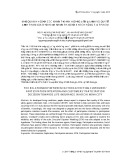
* Corresponding author
E-mail address: wateniwut@polikant.ac.id (W. A. Teniwut)
© 2020 by the authors; licensee Growing Science.
doi: 10.5267/j.uscm.2019.7.009
Uncertain Supply Chain Management 8 (2020) 131–148
Contents lists available at GrowingScience
Uncertain Supply Chain Management
homepage:
www.GrowingScience.com/uscm
Decision support system in supply chain: A systematic literature review
Wellem Anselmus Teniwuta* and Cawalinya Livsanthi Hasyima
aFisheries Agribusiness Study Program, Tual State Fisheries Polytechnic, Langgur, Southeast Maluku District, 97611, Indonesia
C H R O N I C L E A B S T R A C T
Article history:
Received June 11, 2019
Received in revised format June
23, 2019
Accepted July 25 2019
Available online
July
2
5
2019
Systematic literature review in supply chain and decision support system, in general, have been
rapidly performed during the last decade. However, the studies on the epistemological progress
of decision support system related to the supply chain are still lacking. This study intended to
provide comprehensive information on the trends, methodologies and the applications on
different sectors and platforms used by scientists for building their decision support systems in
supply chain. We used different keywords to collect the raw data based on articles published
in well-known journals in the world to select the eligible studies which furthermore assembled.
The data were processed by using bibliometric tool in VOSviewer and Microsoft Excel. The
results of this systematic review give some key learning of the trends on the use of decision
support system on smoothing the flow of supply chain and the logistic performance in the last
decade and also provide a background for future research related to the fields.
.by the authors; licensee Growing Science, Canada 2020©
Keywords:
Decision support system
Systematic literature review
Supply chain, bibliometric
1. Introduction
There is a common understanding from all stakeholders and entrepreneurs around the world about the
importance of information technology to support the business activities in fast-flowing information and
rapid change of customer preference era. The latest trend causes a shift in the production process which
later affects the flow of the supply chain as overall, with the fear of overexploitation and inefficiency
from upstream to downstream. Carter and Rogers (2008) proposed the idea of sustainable supply that
emphasize more on economic, environmental and social dimensions. Decision support system (DSS)
is one of the best features that arise from the latest trend and is also able to support the major concern
in the supply chain. DSS was first mentioned by Gorry and Scott Morton (1971) and it has been widely
used in many applications (Djamasbi & Loiacono, 2008). DSS is intended to support decision-makers
to assist and improve their decisions regarding the process and the outcome of their business activities,
which are in the form of a guidance to select the best sets of option to increase the efficiency, profit
and customer satisfaction in regard to the product (Todd & Benbasat, 1999; Speier & Morris, 2003;
Wang & Benbasat. 2009).

132
Many studies have examined the use of DSS in supporting related business processes. For example in
health sector (Hemmat et al., 2019; Belciug et al., 2020), transportation (Rico et al., 2019; El Abdallaoui
et al., 2018), tourism (Tan et al., 2018; Yo et al., 2017), fisheries and marine affairs (Sholahuddin et
al., 2017; Garmendia et al., 2010), environmental (Amir-Heidari & Raie, 2019); oil industry (Shafiee
et al., 2018). This trend signifies a very versatile applications of DSS combined with many attributes
and tools with other methods to support the decision-making process.
Despite the usefulness of DSS to decrease the complicity of their decision (Chan et al., 2015), decision
support system also faces criticism when current and potential users do not always take advantage of
DSS to support their decision-making, either due to knowledge and awareness, or because of the
structure of the DSS itself. The user often and repeatedly uses the DSS when the easiness and the
usefulness are there (Chan, 2009). Thus, DSS has to be customized based on the work and problem. To
date, data warehouse, data mining (Alkahtani et al. 2019), business intelligence (Delen & Pratt, 2006)
and statistical analysis (De la Rossa et al. 2004) are being adopted into DSS. The current function of
DSS is not only limited to database system but also an expert system that assist decision maker to solve
the problem.
The effectiveness of DSS is also depended on the construction and features, in particular in the supply
chain, the balance of information and availability to transfer demand and supply needed between each
echelon from down-stream to up-stream, makes DSS has to be constructed carefully and
comprehensively to assist the decision-maker in the supply chain. As the number of papers published
in the supply chain area has grown substantially lately, there are also broad areas and approaches that
are used to develop each decision support system in the supply chain, therefore, to address the issue on
obtaining the most effective DSS for supply chain, we conduct a systematic literature review. Garcia
et al. (2016) pointed out the importance of literature review to prevent the failure of build a DSS, thus,
we systematically analyze the literature on DSS on the supply chain, by addressing the following
research questions:
RQ1: What are the most effective models used on DSS in supply chain?
Currently there are many approaches, methods, models and technologies that are used. Therefore, the
answer for this question can shed light on the most common and effective approaches for DSS in supply
chain.
RQ2: What are the activities in supply chain that can be covered and assisted by DSS?
The result of the study can provide broad information of the versatility of DSS in every part of the
supply chain and, at the same time, it also gives information on which part of supply chain we may use
DSS system.
RQ3: What is the common output provide by DSS in supply chain?
The result of this question can provide the most common outputs from DSS that can be used in the
supply chain. This is important to figure out about the power of DSS itself and the result includes the
explicit output (document, guidance, and strategy).
RQ4: What industry uses DSS in supply chain used the most?
DSS applications in the supply chain are broad from medical to tourism. The result of this question can
provide the information about which industry and the most one to use DSS in the supply chain. At the
same time, it provides some information on which industries have used less and this can help find the
gap for future applications of DSS in the supply chain.
In this context, the main aim of this paper is to provide a comprehensive systematic review of the use
of decision support system in the supply chain. Furthermore, this paper is organized into five sections.
Section 1 contains the introduction and research objectives; section 2 is associated with the

W. A. Teniwut and C. L. Hasyim /Uncertain Supply Chain Management
8 (2020)
133
methodology for this review. Section 3 presents the result; Section 4 and Section 5 respectively report
the discussion and conclusion and proposes a research gap and proposed future research.
2. Material and Method
2.1 Data Resources
A systematic review of literature in this study is related to the decision support system in the supply
chain. Systematic literature review is good for locating, selecting, analyzing, appraising and evaluating
the literature that is relevant to a particular research question (Denyer & Tranfield, 2009). The
preparation of the systematic literature review is carried out based on the Preferred Reporting Items for
Systematic Reviews and Meta-Analyses (PRISMA) approach (Liberati et al. 2009). For this reason, the
literature used in this study was taken from several major and respected publishing, such as Science
direct, IEEE, Emerald, Springer, and also added with the largest indexed database in Scopus, this is
due to an effort to gather high-quality paper related to decision support system in the supply chain.
Literature data from 2011-2019 was used in the study, which were obtained by the following keywords:
DSS AND Supply chain; Web DSS and Supply Chain; decision support system AND supply chain.
2.2. Data Selection
Criteria in selecting articles include articles must be in English; full text is available in accordance with
systematic review and research question topics in this study and is limited to pre-determined journals
and databases. Collecting data includes titles, abstracts, years, keywords, publishers and keywords
exported into Ms Excel which are then processed and processed according to the research question
(RQ) in this study. The data collected included 2041 articles from various journals and publishers, then
they were reduced by duplicating and relevance articles as much as 1176 so that the remaining articles
were 865. Furthermore, from the remaining number of articles, we have filtered them based on the
suitability of articles with the topic on this systematic review and obtained 152 articles. In the next step,
we obtained 88 articles to be useful in the systematic review in this study (Fig. 1).
Fig. 1. Data selection process
Data obtained from
database and journals
N= 2041
Article screen based on
duplication and
relevance
N= 865
Article screen based on
topics on this paper
N= 152
Articles screening
based on full paper
verification
N= 88
Excluded
N= 1176
Excluded
N= 713
Excluded
N= 64

134
2.3. Data description
The data obtained and used in this study show that in the past 9 years the number of publications
specifically on the implementation of DSS for supply chains has been increased where the highest
publication was in 2013 with 14 articles followed by the publication in 2018 with 13 articles. The result
has also shown the lowest number of articles published related to DSS in the supply chain was in 2011
with 6 articles followed by 7 articles published in 2016 (Fig. 2). In Fig. 3, it can be seen that in the
recent years from 2016 and above, it appears that the focus of research related to the supply chain
decision support system was on the implementation and evaluation of decision making.
Figure 2. Number of publication used in this study
Fig. 3. Yearly publication main topics
It was further found that the articles published during the last 9 years were published in various journals
evenly and were not stacked in one particular journal (Fig. 4). 88 articles used in this study came from
70 journals and proceedings, which the finding also obtained that the most journals whose articles were
used in this study were 5 articles on Lecture Notes in Computer Science followed by the Journal of
Manufacturing Technology Management, Decision Support Systems and International Journal of
Production Research each with 3 articles and then the rest of the articles were evenly distributed in the
remaining journals. In Fig. 5, it can be seen that based on bibliometric analysis, three topic group
6
9
14
9
11
7
9
13
10
2011 2012 2013 2014 2015 2016 2017 2018 2019
Number publication
Year

W. A. Teniwut and C. L. Hasyim /Uncertain Supply Chain Management 8 (2020)
135
clusters were obtained from 88 articles used in this study. The first red cluster is the main cluster which
is the main topic in DSS and Supply chain. The second cluster which shown in green is the topic that
discusses the approach used, then the third blue cluster is obtained from the application of the built-in
DSS.
Fig. 4. Publication based on the journal' title
Fig. 5. Network publication topics
3. Results
RQ1: What are the most effective models used on DSS in supply chain?
The results obtained are shown in Fig. 6 and Table 1. It can be seen that the most widely used approach
in the application of the supply chain decision support system is numerical simulation which includes
the use of linear programming, semantic and fuzzy logic where 63% of articles use numerical analysis
on DSS chains supply. Furthermore, the results of a review analysis also found that the use of multi-
criteria decision making and multi-objective decision making were in the second place and 20% of the
articles used these techniques in this study. Simulation analysis is in the third position where 9.10% of
articles use a simulation approach to build DSS in the supply chain. Then respectively, the web-based
approach combined with other methods such as simulation, numerical analysis and spatial was 8%,
followed by 3% for artificial intelligence, 3% on spatial-based and 1% on big data.
0 0.5 1 1.5 2 2.5
CEUR Workshop Proceedings
Proceedings - 2011 8th International Conference on Fuzzy Systems and…
Intelligent Systems Reference Library
11th International Industrial Simulation Conference 2013, ISC 2013
IFIP Advances in Information and Communication Technology
International Journal of Technology Intelligence and Planning
Annals of Operations Research
Lecture Notes in Computer Science (including subseries Lecture Notes in Artificial…
International Journal of Logistics Systems and Management
Proceedings - CIE 45: 2015 International Conference on Computers and Industrial…
Lecture Notes in Computer Science (including subseries Lecture Notes in Artificial…
Food Control
Lecture Notes in Computer Science (including subseries Lecture Notes in Artificial…
Computers and Industrial Engineering
International Journal of Production Research
Behaviour and Information Technology
Lecture Notes in Information Systems and Organisation
Number of publication
Journal Title










![Phân tích mối quan hệ CVP: Chương 4 [Hướng dẫn chi tiết]](https://cdn.tailieu.vn/images/document/thumbnail/2012/20121029/duysu1988/135x160/8431351482444.jpg)















